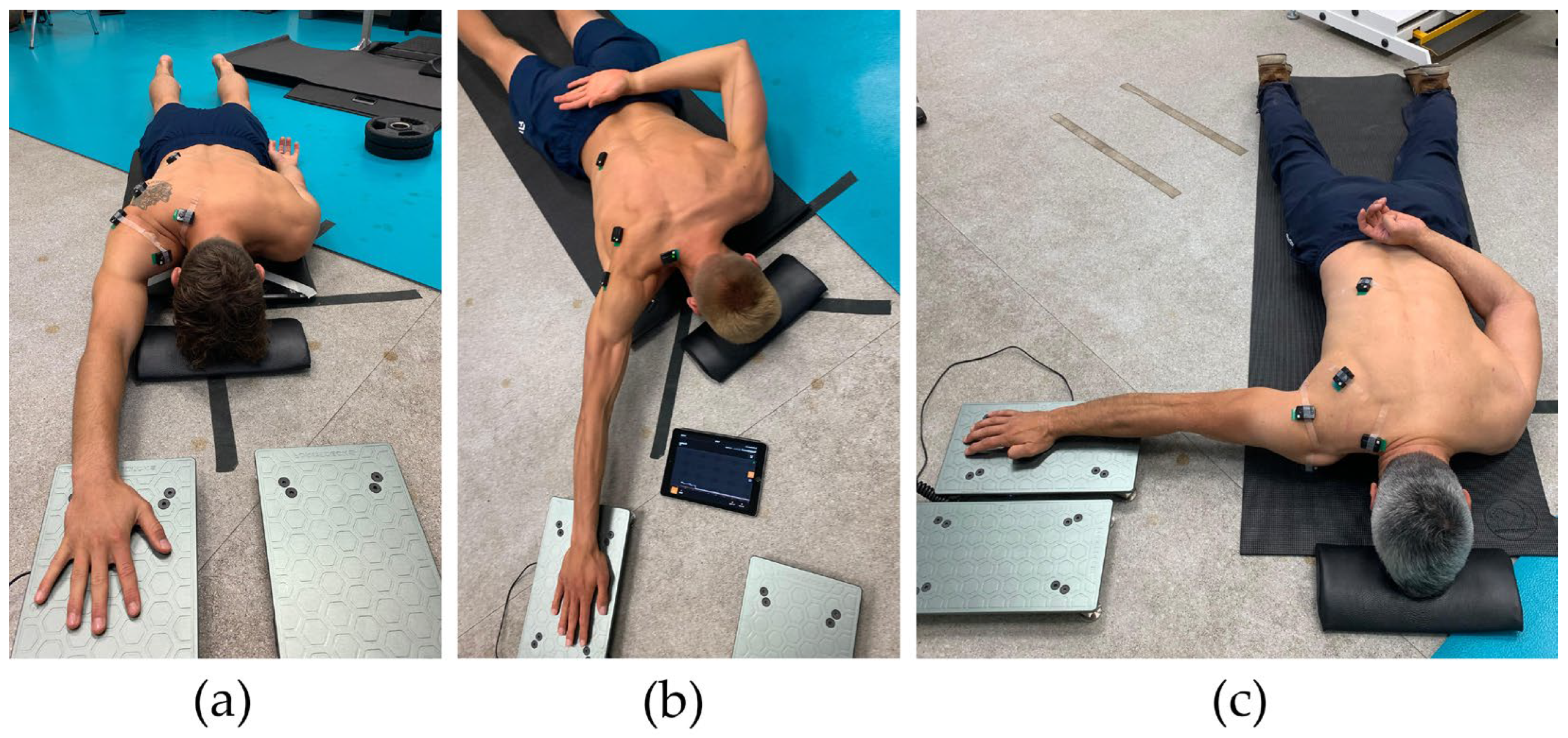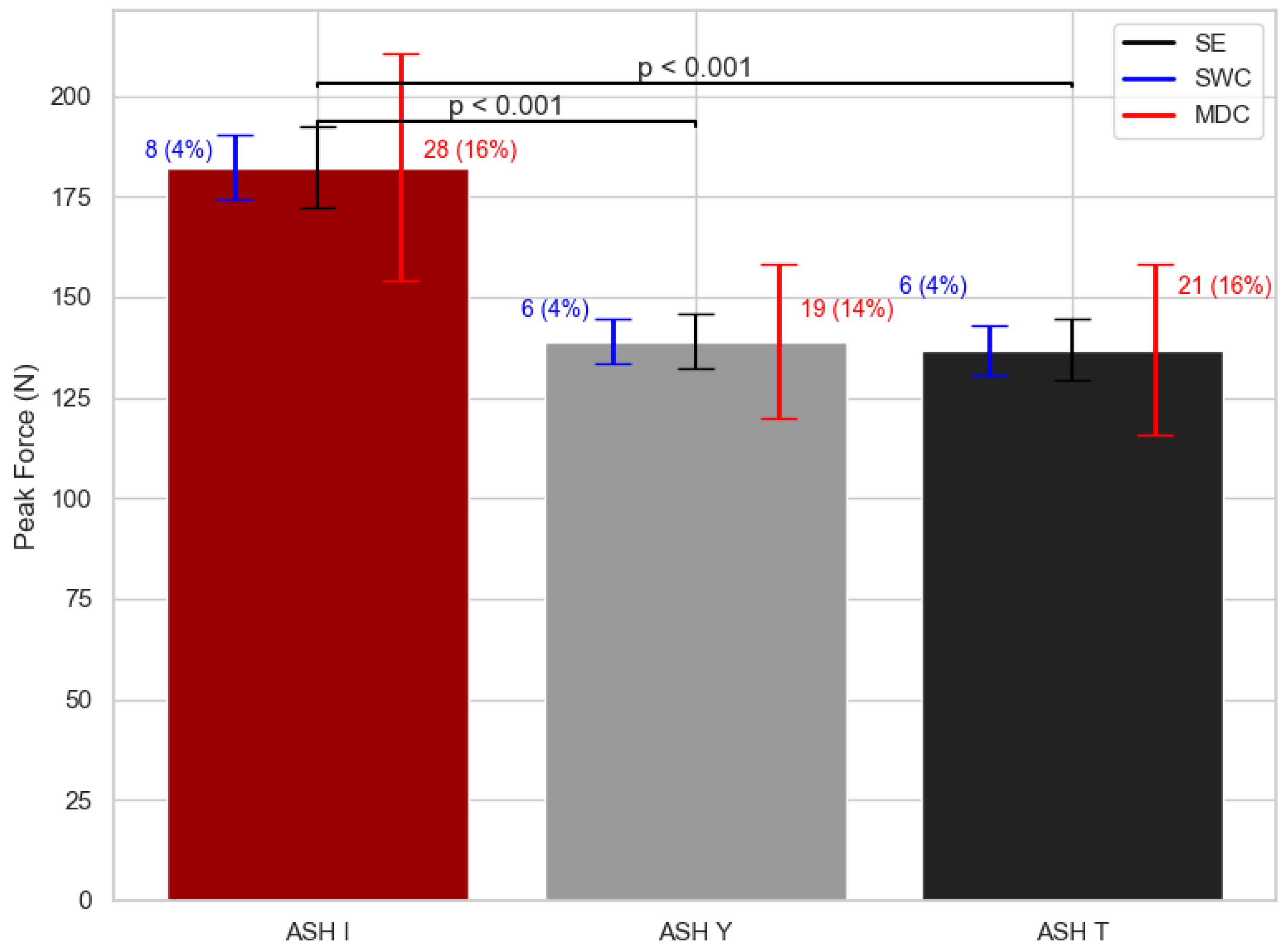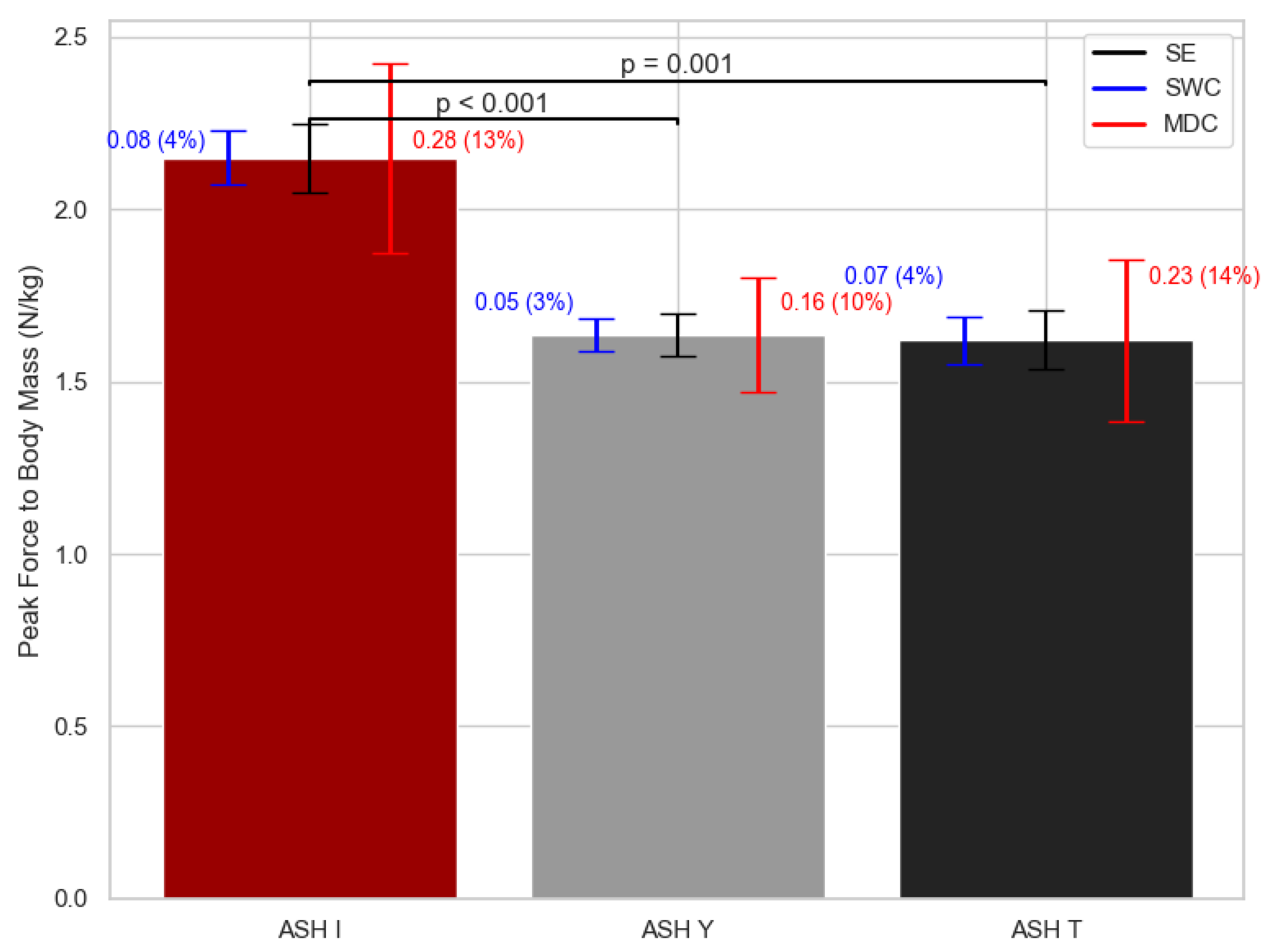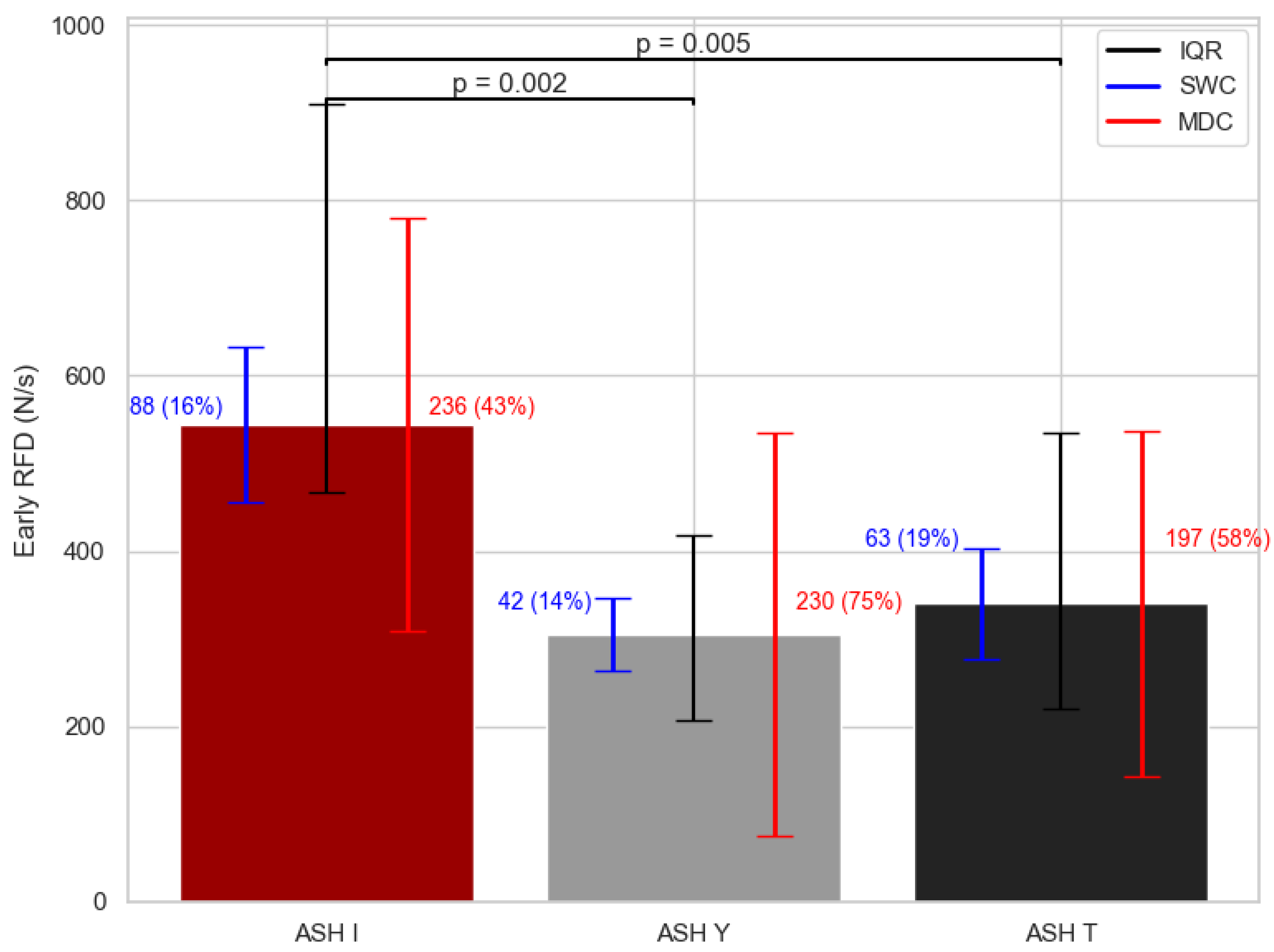Early Rate of Force Development and Maximal Strength at Different Positions of the Athletic Shoulder Test in Baseball Players
Abstract
1. Introduction
2. Materials and Methods
2.1. Participants
2.2. Procedures
Isometric Shoulder Flexion Strength Assessment
2.3. Data Acquisition and Processing
2.4. Statistical Analysis
3. Results
4. Discussion
5. Conclusions
Author Contributions
Funding
Institutional Review Board Statement
Informed Consent Statement
Data Availability Statement
Acknowledgments
Conflicts of Interest
Abbreviations
| PF | Peak Force |
| RFD | Rate of Force Development |
| ASH | Athletic Shoulder |
| ICC | Intraclass Correlation Coefficient |
| SEM | Standard Error of Measurement |
| CV | Coefficient of Variation |
| SWC | Smallest Worthwhile Change |
| MDC | Minimal Detectable Change |
| MLB | Major League Baseball |
References
- Birfer, R.; Sonne, M.W.; Holmes, M.W. Manifestations of Muscle Fatigue in Baseball Pitchers: A Systematic Review. PeerJ 2019, 7, e7390. [Google Scholar] [CrossRef]
- Black, G.M.; Gabbett, T.J.; Cole, M.H.; Naughton, G. Monitoring Workload in Throwing-Dominant Sports: A Systematic Review. Sports Med. 2016, 46, 1503–1516. [Google Scholar] [CrossRef]
- Roach, N.T.; Venkadesan, M.; Rainbow, M.J.; Lieberman, D.E. Elastic Energy Storage in the Shoulder and the Evolution of High-Speed Throwing in Homo. Nature 2013, 498, 483–486. [Google Scholar] [CrossRef]
- Escamilla, R.F.; Barrentine, S.W.; Fleisig, G.S.; Zheng, N.; Takada, Y.; Kingsley, D.; Andrews, J.R. Pitching Biomechanics as a Pitcher Approaches Muscular Fatigue during a Simulated Baseball Game. Am. J. Sports Med. 2007, 35, 23–33. [Google Scholar] [CrossRef]
- Escamilla, R.F.; Slowik, J.S.; Fleisig, G.S. Effects of Contralateral Trunk Tilt on Shoulder and Elbow Injury Risk and Pitching Biomechanics in Professional Baseball Pitchers. Am. J. Sports Med. 2023, 51, 935–941. [Google Scholar] [CrossRef]
- Seroyer, S.T.; Nho, S.J.; Bach, B.R.; Bush-Joseph, C.A.; Nicholson, G.P.; Romeo, A.A. The Kinetic Chain in Overhand Pitching: Its Potential Role for Performance Enhancement and Injury Prevention. Sports Health 2010, 2, 135–146. [Google Scholar] [CrossRef]
- Escamilla, R.F.; Andrews, J.R. Shoulder Muscle Recruitment Patterns and Related Biomechanics during Upper Extremity Sports. Sports Med. 2009, 39, 569–590. [Google Scholar] [CrossRef]
- Stodden, D.F.; Fleisig, G.S.; McLean, S.P.; Andrews, J.R. Relationship of Biomechanical Factors to Baseball Pitching Velocity: Within Pitcher Variation. J. Appl. Biomech. 2005, 21, 44–56. [Google Scholar] [CrossRef]
- Job, T.D.W.; Cross, M.R.; Cronin, J.B. Shoulder Internal and External Rotation Strength Assessment in Baseball Pitchers: Normative Data and Reliability. J. Strength Cond. Res. 2025, 39, e634–e638. [Google Scholar] [CrossRef]
- Job, T.D.W.; Cross, M.R.; Cronin, J.B. Relationship of Shoulder Internal and External Rotation Peak Force and Rate of Force Development to Throwing Velocity in High School and Collegiate Pitchers. J. Biomech. 2024, 176, 112339. [Google Scholar] [CrossRef]
- Boccia, G.; D’Emanuele, S.; Brustio, P.R.; Rainoldi, A.; Schena, F.; Tarperi, C. Decreased Neural Drive Affects the Early Rate of Force Development after Repeated Burst-like Isometric Contractions. Scand. J. Med. Sci. Sports 2024, 34, e14528. [Google Scholar] [CrossRef]
- D’Emanuele, S.; Maffiuletti, N.A.; Tarperi, C.; Rainoldi, A.; Schena, F.; Boccia, G. Rate of Force Development as an Indicator of Neuromuscular Fatigue: A Scoping Review. Front. Hum. Neurosci. 2021, 15, 701916. [Google Scholar] [CrossRef]
- Kozinc, Ž.; Smajla, D.; Šarabon, N. The Rate of Force Development Scaling Factor: A Review of Underlying Factors, Assessment Methods and Potential for Practical Applications. Eur. J. Appl. Physiol. 2022, 122, 861–873. [Google Scholar] [CrossRef]
- Paul, R.W.; Sirch, F.R.; Vata, A.; Zhu, E.; Alberta, F.G.; Erickson, B.J.; Thomas, S.J. Chronic Adaptations of the Shoulder in Baseball Pitchers: A Systematic Review. Am. J. Sports Med. 2025, 03635465251317202. [Google Scholar] [CrossRef]
- Mine, K.; Milanese, S.; Jones, M.A.; Saunders, S.; Onofrio, B. Risk Factors of Shoulder and Elbow Injuries in Baseball: A Scoping Review of 3 Types of Evidence. Orthop. J. Sports Med. 2021, 9, 232596712110646. [Google Scholar] [CrossRef]
- Matsel, K.A.; Butler, R.J.; Malone, T.R.; Hoch, M.C.; Westgate, P.M.; Uhl, T.L. Current Concepts in Arm Care Exercise Programs and Injury Risk Reduction in Adolescent Baseball Players: A Clinical Review. Sports Health 2021, 13, 245–250. [Google Scholar] [CrossRef]
- Ashworth, B.; Hogben, P.; Singh, N.; Tulloch, L.; Cohen, D.D. The Athletic Shoulder (ASH) Test: Reliability of a Novel Upper Body Isometric Strength Test in Elite Rugby Players. BMJ Open Sport Exerc. Med. 2018, 4, e000365. [Google Scholar] [CrossRef]
- Del Águila, A.; Ashworth, B.; Cohen, D.D. Relationship between Service Velocity and ASH Test Performance in Professional Volleyball Players. In Proceedings of the 4th Annual Meeting Strength and Conditioning Society, Porto, Portugal, 12–13 November 2021. [Google Scholar] [CrossRef]
- Tooth, C.; Forthomme, B.; Croisier, J.-L.; Gofflot, A.; Bornheim, S.; Schwartz, C. The Modified-Athletic Shoulder Test: Reliability and Validity of a New On-Field Assessment Tool. Phys. Ther. Sport 2022, 58, 8–15. [Google Scholar] [CrossRef]
- Maffiuletti, N.A.; Aagaard, P.; Blazevich, A.J.; Folland, J.; Tillin, N.; Duchateau, J. Rate of Force Development: Physiological and Methodological Considerations. Eur. J. Appl. Physiol. 2016, 116, 1091–1116. [Google Scholar] [CrossRef]
- Dyrna, F.; Kumar, N.S.; Obopilwe, E.; Scheiderer, B.; Comer, B.; Nowak, M.; Romeo, A.A.; Mazzocca, A.D.; Beitzel, K. Relationship between Deltoid and Rotator Cuff Muscles during Dynamic Shoulder Abduction: A Biomechanical Study of Rotator Cuff Tear Progression. Am. J. Sports Med. 2018, 46, 1919–1926. [Google Scholar] [CrossRef]
- Hecker, A.; Aguirre, J.; Eichenberger, U.; Rosner, J.; Schubert, M.; Sutter, R.; Wieser, K.; Bouaicha, S. Deltoid Muscle Contribution to Shoulder Flexion and Abduction Strength: An Experimental Approach. J. Shoulder Elbow. Surg. 2021, 30, e60–e68. [Google Scholar] [CrossRef]
- Escamilla, R.F.; Yamashiro, K.; Paulos, L.; Andrews, J.R. Shoulder Muscle Activity and Function in Common Shoulder Rehabilitation Exercises. Sports Med. 2012, 39, 663–685. [Google Scholar] [CrossRef]
- Viehöfer, A.F.; Gerber, C.; Favre, P.; Bachmann, E.; Snedeker, J.G. A Larger Critical Shoulder Angle Requires More Rotator Cuff Activity to Preserve Joint Stability. J. Orthop. Res. 2015, 34, 961–968. [Google Scholar] [CrossRef]
- Yanagawa, T.; Goodwin, C.J.; Shelburne, K.B.; Giphart, J.E.; Torry, M.R.; Pandy, M.G. Contributions of the Individual Muscles of the Shoulder to Glenohumeral Joint Stability during Abduction. J. Biomech. Eng. 2008, 130, 021024. [Google Scholar] [CrossRef]
- Ackland, D.C.; Pandy, M.G. Lines of Action and Stabilizing Potential of the Shoulder Musculature. J. Anat. 2009, 215, 184–197. [Google Scholar] [CrossRef]
- Yeung, A.; Fernando, A.; Patel, M.; Gatto, L.; Ackland, D.C. Muscle and Joint Function in the Rotator Cuff Deficient Shoulder. J. Orthop. Res. 2024, 42, 2131–2139. [Google Scholar] [CrossRef]
- Oh, J.H.; Jun, B.J.; McGarry, M.H.; Lee, T.Q. Does a Critical Rotator Cuff Tear Stage Exist? J. Bone Joint Surg. Am. 2011, 93, 2100–2109. [Google Scholar] [CrossRef]
- Zushi, K.; Kariyama, Y.; Ogata, M. Longitudinal Changes in the Rate of Force Development during Single-Leg Press and Sports Performance for Jumpers. Jpn. J. Phys. Fit. Sports Med. 2020, 69, 383–392. [Google Scholar] [CrossRef]
- Peñailillo, L.; Blazevich, A.; Numazawa, H.; Nosaka, K. Rate of Force Development as a Measure of Muscle Damage. Scand. J. Med. Sci. Sports 2014, 25, 417–427. [Google Scholar] [CrossRef]
- Smith, T.M.; Hester, G.M.; Ha, P.L.; Olmos, A.A.; Stratton, M.T.; VanDusseldorp, T.A.; Feito, Y.; Dalton, B.E. Sit-To-Stand Kinetics and Correlates of Performance in Young and Older Males. Arch. Gerontol. Geriatr. 2020, 91, 104215. [Google Scholar] [CrossRef]
- Zaras, N.; Stasinaki, A.-N.; Spiliopoulou, P.; Arnaoutis, G.; Hadjicharalambous, M.; Terzis, G. Rate of Force Development, Muscle Architecture, and Performance in Elite Weightlifters. Int. J. Sports Physiol. Perform. 2020, 16, 216–223. [Google Scholar] [CrossRef]
- Martinopoulou, K.; Donti, O.; Sands, W.A.; Terzis, G.; Bogdanis, G.C. Evaluation of the Isometric and Dynamic Rates of Force Development in Multi-Joint Muscle Actions. J. Hum. Kinet. 2022, 81, 135–148. [Google Scholar] [CrossRef]
- Buk Jørgensen, T.; Mejer, P.M.; Kvorning, T.; Thomas, R.; Breenfeldt Andersen, A.; Junge, N.; Nybo, L.; Lundbye-Jensen, J. Optimizing Isometric Midthigh Pull Testing Protocols: Impact on Peak Force and Rate of Force Development and Their Association with Jump Performance. J. Sports Med. Phys. Fit. 2024, 64, 993–1002. [Google Scholar] [CrossRef]
- Comfort, P.; Jones, P.A.; Thomas, C.; Dos’Santos, T.; McMahon, J.J.; Suchomel, T.J. Changes in Early and Maximal Isometric Force Production in Response to Moderate- and High-Load Strength and Power Training. J. Strength Cond. Res. 2020, 36, 1. [Google Scholar] [CrossRef]
- Kara, D.; Harput, G.; Duzgun, I. The Effect of Shoulder Abduction Angle on Trapezius Muscle Activity during Scapular Retraction Exercise. J. Athl. Train. 2021, 56, 1327–1333. [Google Scholar] [CrossRef]
- Megumi Wakuda de Abreu Vasconcelos, C.; Ricardo Lopes, C.; Martins Almeida, V.; Krause Neto, W.; Soares, E. Effect of Different Grip Position and Shoulder- Abduction Angle on Muscle Strength and Activation during the Seated Cable Row. Int. J. Strength Cond. 2023, 3. [Google Scholar] [CrossRef]
- Comfort, P.; Dos’Santos, T.; Jones, P.A.; McMahon, J.J.; Suchomel, T.J.; Bazyler, C.; Stone, M.H. Normalization of Early Isometric Force Production as a Percentage of Peak Force during Multijoint Isometric Assessment. Int. J. Sports Physiol. Perform. 2019, 15, 478–482. [Google Scholar] [CrossRef]
- Andersen, L.L.; Andersen, J.L.; Zebis, M.K.; Aagaard, P. Early and Late Rate of Force Development: Differential Adaptive Responses to Resistance Training? Scand. J. Med. Sci. Sports 2010, 20, e162–e169. [Google Scholar] [CrossRef]
- McHugh, M.P.; Tyler, T.F.; Mullaney, M.J.; Mirabella, M.R.; Nicholas, S.J. The Effect of a High Pitch Volume on Musculoskeletal Adaptations in High School Baseball Pitchers. Am. J. Sports Med. 2016, 44, 2246–2254. [Google Scholar] [CrossRef]
- Lazu, A.L.; Love, S.D.; Butterfield, T.A.; English, R.; Uhl, T.L. The Relationship between Pitching Volume and Arm Soreness in Collegiate Baseball Pitchers. Int. J. Sports Phys. Ther. 2019, 14, 97. [Google Scholar] [CrossRef]
- Zaremski, J.L.; Zeppieri, G.; Jones, D.L.; Tripp, B.L.; Bruner, M.; Vincent, H.K.; Horodyski, M. Unaccounted Workload Factor: Game-Day Pitch Counts in High School Baseball Pitchers—An Observational Study. Orthop. J. Sports Med. 2018, 6, 2325967118765255. [Google Scholar] [CrossRef]
- Baseball, M.L. MLB|Pitch Smart|Pitching Guidelines|Ages 19–22. MLB.com. Available online: https://www.mlb.com/pitch-smart/pitching-guidelines/ages-19-22 (accessed on 2 February 2025).
- Dowling, B.; McNally, M.P.; Chaudhari, A.M.W.; Oñate, J.A. A Review of Workload-Monitoring Considerations for Baseball Pitchers. J. Athl. Train. 2020, 55, 911–917. [Google Scholar] [CrossRef]
- Bakshi, N.K.; Inclan, P.M.; Kirsch, J.M.; Bedi, A.; Agresta, C.; Freehill, M.T. Current Workload Recommendations in Baseball Pitchers: A Systematic Review. Am. J. Sports Med. 2019, 48, 229–241. [Google Scholar] [CrossRef]
- Liaghat, B.; Juul-Kristensen, B.; Frydendal, T.; Marie Larsen, C.; Søgaard, K.; Ilkka Tapio Salo, A. Competitive Swimmers with Hypermobility Have Strength and Fatigue Deficits in Shoulder Medial Rotation. J. Electromyogr. Kinesiol. 2018, 39, 1–7. [Google Scholar] [CrossRef]
- Parkinson, A.O.; Apps, C.L.; Morris, J.G.; Barnett, C.T.; Lewis, M.G.C. The Calculation, Thresholds and Reporting of Inter-Limb Strength Asymmetry: A Systematic Review. J. Sports Sci. Med. 2021, 20, 594–617. [Google Scholar] [CrossRef]
- Mala, L.; Maly, T.; Cabell, L.; Hank, M.; Bujnovsky, D.; Zahalka, F. Anthropometric, Body Composition, and Morphological Lower Limb Asymmetries in Elite Soccer Players: A Prospective Cohort Study. Int. J. Environ. Res. Public Health 2020, 17, 1140. [Google Scholar] [CrossRef]
- Intelangelo, L.; Lassaga, I.; Gonzalo, E.; Mendoza, C.; Ormazabal, J.M.; Roulet, I.; Bevacqua, N.; Jerez-Mayorga, D. Is Strength the Main Risk Factor of Overuse Shoulder Injuries? A Cohort Study of 296 Amateur Overhead Athletes. Sports Health 2024, 39, 19417381241298287. [Google Scholar] [CrossRef]
- Arnold, A.; Thigpen, C.; Beattie, P.; Fritz, S.; Kissenberth, M.; Tokish, J.; Shanley, E. 2 ATI Physical Therapy, 3 Physical Therapy, University of South Carolina, 4 Orthopaedics, Steadman Hawkins Clinic of the Carolinas, 5 Orthopaedics. Int. J. Sports Phys. Ther. 2022, 17, 259–269. [Google Scholar] [CrossRef]
- Trunt, A.; Fisher, B.T.; MacFadden, L.N. Athletic Shoulder Test Differences Exist Bilaterally in Healthy Pitchers. Int. J. Sports Phys. Ther. 2022, 17, 715–723. [Google Scholar] [CrossRef]
- Schilling, D.T.; Elazzazi, A.M. Shoulder Strength and Closed Kinetic Chain Upper Extremity Stability Test Performance in Division III Collegiate Baseball and Softball Players. Int. J. Sports Phys. Ther. 2021, 16, 844–853. [Google Scholar] [CrossRef]
- Zhang, Y.; Hedo, R.; Rivera, A.; Rull, R.; Richardson, S.; Tu, X.M. Post Hoc Power Analysis: Is It an Informative and Meaningful Analysis? Gen. Psychiatr. 2019, 32, e100069. [Google Scholar] [CrossRef] [PubMed]
- Heckman, M.G.; Davis, J.M.; Crowson, C.S. Post Hoc Power Calculations: An Inappropriate Method for Interpreting the Findings of a Research Study. J. Rheumatol. 2022, 49, 867–870. [Google Scholar] [CrossRef] [PubMed]




| Test | PF (N) | PF/BM (N/kg) | Early RFD (N/s) |
|---|---|---|---|
| Mean (SD) | Mean (SD) | Median (IQR 25th–75th) | |
| ASH I | 182 (41) | 2.15 (0.39) | 545 (468–910) |
| ASH Y | 139 (28) | 1.64 (0.28) | 305 (208–418) |
| ASH T | 137 (31) | 1.62 (0.34) | 340 (220–535) |
Disclaimer/Publisher’s Note: The statements, opinions and data contained in all publications are solely those of the individual author(s) and contributor(s) and not of MDPI and/or the editor(s). MDPI and/or the editor(s) disclaim responsibility for any injury to people or property resulting from any ideas, methods, instructions or products referred to in the content. |
© 2025 by the authors. Licensee MDPI, Basel, Switzerland. This article is an open access article distributed under the terms and conditions of the Creative Commons Attribution (CC BY) license (https://creativecommons.org/licenses/by/4.0/).
Share and Cite
Ashworth, B.; Hank, M.; Khaiyat, O.; Coyles, G.; Fallon Verbruggen, F.; Zemkova, E.; Zahalka, F.; Maly, T. Early Rate of Force Development and Maximal Strength at Different Positions of the Athletic Shoulder Test in Baseball Players. Sports 2025, 13, 300. https://doi.org/10.3390/sports13090300
Ashworth B, Hank M, Khaiyat O, Coyles G, Fallon Verbruggen F, Zemkova E, Zahalka F, Maly T. Early Rate of Force Development and Maximal Strength at Different Positions of the Athletic Shoulder Test in Baseball Players. Sports. 2025; 13(9):300. https://doi.org/10.3390/sports13090300
Chicago/Turabian StyleAshworth, Ben, Mikulas Hank, Omid Khaiyat, Ginny Coyles, Ferdia Fallon Verbruggen, Erika Zemkova, Frantisek Zahalka, and Tomas Maly. 2025. "Early Rate of Force Development and Maximal Strength at Different Positions of the Athletic Shoulder Test in Baseball Players" Sports 13, no. 9: 300. https://doi.org/10.3390/sports13090300
APA StyleAshworth, B., Hank, M., Khaiyat, O., Coyles, G., Fallon Verbruggen, F., Zemkova, E., Zahalka, F., & Maly, T. (2025). Early Rate of Force Development and Maximal Strength at Different Positions of the Athletic Shoulder Test in Baseball Players. Sports, 13(9), 300. https://doi.org/10.3390/sports13090300








